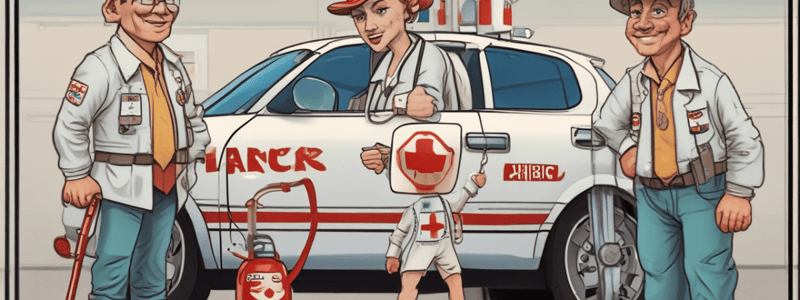Podcast
Questions and Answers
In which scenario is hands-only CPR not fully recommended?
In which scenario is hands-only CPR not fully recommended?
- Adults who collapse from cardiac arrest
- Infants and small children
- Drowning victims
- All of the above (correct)
Why is hands-only CPR considered appropriate for infants and children when the only person available to render care is not trained in rescue breathing?
Why is hands-only CPR considered appropriate for infants and children when the only person available to render care is not trained in rescue breathing?
- Because someone not properly trained in rescue breathing would inadvertently delay the circulation of oxygen in the victim's bloodstream (correct)
- Because it reduces the risk of further injury
- Because it is a simpler procedure
- Because it is a more effective procedure
What is the primary benefit of high-quality, 'fast-n-hard' chest compressions in CPR?
What is the primary benefit of high-quality, 'fast-n-hard' chest compressions in CPR?
- It helps reduce further injury
- It helps restore breathing
- It helps restore a normal heart rhythm
- It circulates oxygen in the victim's bloodstream (correct)
What should be initiated as quickly as possible after a cardiac arrest is evident?
What should be initiated as quickly as possible after a cardiac arrest is evident?
Why is hands-only CPR a highly effective alternative to full-CPR, especially in adults and witnessed arrests?
Why is hands-only CPR a highly effective alternative to full-CPR, especially in adults and witnessed arrests?
What should be done before starting CPR on an unresponsive victim?
What should be done before starting CPR on an unresponsive victim?
What should be continued without unnecessary delay until an AED or EMS arrives to take over care of the victim?
What should be continued without unnecessary delay until an AED or EMS arrives to take over care of the victim?
Why is rescue breathing important for infant and child victims of cardiac arrest?
Why is rescue breathing important for infant and child victims of cardiac arrest?
What is the recommended personal protective equipment when performing CPR on a victim?
What is the recommended personal protective equipment when performing CPR on a victim?
Where should you position the unresponsive victim?
Where should you position the unresponsive victim?
How should you position your body during CPR?
How should you position your body during CPR?
Where should you place the heel of your hand during CPR?
Where should you place the heel of your hand during CPR?
What should you do if you feel the little indentation or 'notch' at the bottom of the victim's sternum?
What should you do if you feel the little indentation or 'notch' at the bottom of the victim's sternum?
Why should you interlace your fingers during CPR?
Why should you interlace your fingers during CPR?
What precaution should you take when performing CPR on a victim with bodily fluids present?
What precaution should you take when performing CPR on a victim with bodily fluids present?
Why is it recommended to perform 'hands-only' CPR on a victim with dry intact skin?
Why is it recommended to perform 'hands-only' CPR on a victim with dry intact skin?
What should you do first when performing hands-only CPR?
What should you do first when performing hands-only CPR?
What is the recommended method for assessing a victim's level of consciousness in hands-only CPR?
What is the recommended method for assessing a victim's level of consciousness in hands-only CPR?
What should you wear to protect yourself when performing hands-only CPR?
What should you wear to protect yourself when performing hands-only CPR?
When should you start chest compressions in hands-only CPR?
When should you start chest compressions in hands-only CPR?
What type of chest compressions should you deliver in hands-only CPR?
What type of chest compressions should you deliver in hands-only CPR?
Who should you ask to call 911 when performing hands-only CPR?
Who should you ask to call 911 when performing hands-only CPR?
What should you do after starting hands-only CPR?
What should you do after starting hands-only CPR?
Why is it important to be aware of your surroundings when performing hands-only CPR?
Why is it important to be aware of your surroundings when performing hands-only CPR?
Flashcards are hidden until you start studying
Study Notes
Hands-Only CPR Limitations
- Not fully recommended for treating infants and small children, drowning victims, and victims who collapse from a known breathing problem, such as carbon monoxide poisoning.
- Younger victims benefit more from the rescue-breathing portion of the procedure.
Hands-Only CPR for Infants and Children
- Considered appropriate when the only person available to render care is not trained in rescue breathing.
- High-quality "fast-n-hard" chest compressions offer a better chance of survival than awaiting help to arrive.
Initiating Hands-Only CPR
- Check the scene and make sure it's safe for you to proceed.
- Check the victim's level of consciousness by tapping them on the shoulder and asking loudly, "are you okay".
- Phone for help or ask someone nearby to call 911.
Conducting Hands-Only CPR
- Wear protective exam gloves, if available.
- Position the victim on their back on a solid surface.
- Position your body on either side of the victim in the area of their upper chest.
- Locate the proper hand position by placing the heel of one hand on the center of the victim's sternum.
- Interlace your fingers and keep your fingertips off the chest.
- Deliver continuous high-quality "fast-n-hard" chest compressions without delay.
Important Points to Hands-Only CPR
- Always be aware of your surroundings and do not enter an unsafe scene to render care.
- Protect yourself with at least exam gloves.
- Deliver continuous high-quality "fast-n-hard" chest compressions without delay as soon as it is determined the victim isn't responsive/breathing.
Studying That Suits You
Use AI to generate personalized quizzes and flashcards to suit your learning preferences.




